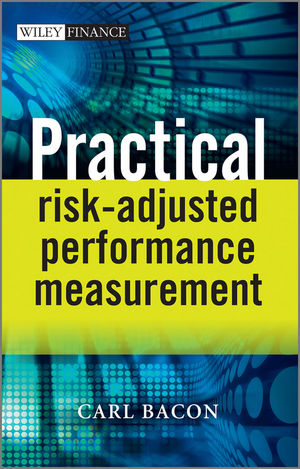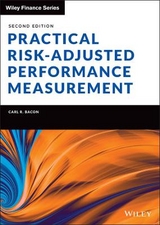
Practical Risk–Adjusted Performance Measurement
John Wiley & Sons Inc (Verlag)
978-1-118-36974-6 (ISBN)
- Titel erscheint in neuer Auflage
- Artikel merken
A practitioner's guide to ex-post performance measurement techniques Risk within asset management firms has an undeserved reputation for being an overly complex, mathematical subject. This book simplifies the subject and demonstrates with practical examples that risk is perfectly straightforward and not as complicated as it might seem. Unlike most books written on portfolio risk, which generally focus on ex-ante risk from an academic perspective using complicated language and no worked examples, this book focuses on ex-post risk from a buy side, asset management, risk practitioners perspective, including a number of practical worked examples for risk measures and their interpretation.
CARL BACON CIPM, joined StatPro Group plc as Chairman in April 2000. StatPro is a platform for Portfolio Analytics, Valuation, Reporting and Research for the investment community. Carl also runs his own consultancy business providing advice to asset managers on various risk and performance measurement issues. Prior to joining StatPro Carl was Director of Risk Control and Performance at Foreign & Colonial Management Ltd, Vice President Head of Performance (Europe) for J P Morgan Investment Management Inc., and Head of Performance for Royal Insurance Asset Management. Carl holds a BSc Hons. in Mathematics from Manchester University and is a member of the Advisory Board of the Journal of Performance Measurement A founder member of both the Investment Performance Council and GIPS(R), Carl is chair of the GIPS Executive Committee, chair of the Verification Sub-Committee and a member of the UK Investment Performance Committee. Carl is also the founder of The Freedom Index Company and is also the author of Practical Portfolio Performance Measurement and Attribution part of the Wiley Finance Series, numerous articles and papers and editor of Advanced Portfolio Attribution Analysis.
Preface xv Acknowledgements xvii 1 Introduction 1 Definition of risk 1 Risk types 1 Risk management v risk control 4 Risk aversion 4 Ex-post and ex-ante 4 Dispersion 5 2 Descriptive Statistics 7 Mean (or arithmetic mean) 7 Annualised return 8 Continuously compounded returns (or log returns) 8 Winsorised mean 9 Mean absolute deviation (or mean deviation) 9 Variance 10 Mean difference (absolute mean difference or Gini mean difference) 12 Relative mean difference 14 Bessel s correction (population or sample, n or n 1) 14 Sample variance 17 Standard deviation (variability or volatility) 17 Annualised risk (or time aggregation) 18 The Central Limit Theorem 19 Janssen annualisation 19 Frequency and number of data points 19 Normal (or Gaussian) distribution 21 Histograms 22 Skewness (Fisher s or moment skewness) 22 Sample skewness 24 Kurtosis (Pearson s kurtosis) 24 Excess kurtosis (or Fisher s kurtosis) 25 Sample kurtosis 25 Bera-Jarque statistic (or Jarque-Bera) 27 Covariance 28 Sample covariance 30 Correlation ( ) 30 Sample correlation 32 Up capture indicator 32 Down capture indicator 34 Up number ratio 34 Down number ratio 34 Up percentage ratio 35 Down percentage ratio 35 Percentage gain ratio 35 Hurst index (or Hurst exponent) 35 Bias ratio 37 3 Simple Risk Measures 43 Performance appraisal 43 Sharpe ratio (reward to variability, Sharpe index) 43 Roy ratio 46 Risk free rate 46 Alternative Sharpe ratio 47 Revised Sharpe ratio 48 Adjusted Sharpe ratio 48 Skewness-kurtosis ratio 49 MAD ratio 49 Gini ratio 52 Relative risk 53 Tracking error (or tracking risk, relative risk, active risk) 53 Relative skewness 54 Relative kurtosis 55 Information ratio 55 Geometric information ratio 56 Modified information ratio 57 Adjusted information ratio 61 Relative Hurst 61 4 Regression Analysis 69 Regression equation 69 Regression alpha ( R) 70 Regression beta ( R) 70 Regression epsilon ( R) 70 Capital Asset Pricing Model (CAPM) 71 Beta ( ) (systematic risk or volatility) 71 Jensen s alpha (Jensen s measure or Jensen s differential return or ex-post alpha) 72 Annualised alpha 72 Bull beta ( +) 73 Bear beta ( ) 73 Beta timing ratio 73 Market timing 78 Systematic risk 81 R2 (or coefficient of determination) 83 Specific or residual risk 83 Treynor ratio (reward to volatility) 84 Modified Treynor ratio 86 Appraisal ratio (or Treynor-Black ratio) 86 Modified Jensen 87 Fama decomposition 88 Selectivity 88 Diversification 88 Net selectivity 89 Fama-French three factor model 89 Three factor alpha (or Fama-French alpha) 91 Carhart four factor model 91 Four factor alpha (or Carhart s alpha) 91 K ratio 91 5 Drawdown 97 Drawdown 97 Average drawdown 97 Maximum drawdown (or peak to valley drawdown) 98 Largest individual drawdown 98 Recovery time (or drawdown duration) 98 Drawdown deviation 98 Ulcer index 99 Pain index 100 Calmar ratio (or drawdown ratio) 100 MAR ratio 100 Sterling ratio 100 Sterling-Calmar ratio 101 Burke ratio 102 Modified Burke ratio 102 Martin ratio (or Ulcer performance index) 102 Pain ratio 103 Lake ratio 103 Peak ratio 106 6 Partial Moments 107 Downside risk (or semi-standard deviation) 107 Pure downside risk 108 Half variance (or semi-variance) 108 Upside risk (or upside uncertainty) 108 Mean absolute moment 109 Omega ratio () 110 Bernardo and Ledoit (or gain-loss) ratio 110 d ratio 110 Omega-Sharpe ratio 111 Sortino ratio 112 Reward to half-variance 112 Downside risk Sharpe ratio 113 Downside information ratio 113 Kappa (Kl) (or Sortino-Satchell ratio) 113 Upside potential ratio 114 Volatility skewness 114 Variability skewness 115 Farinelli-Tibiletti ratio 115 Prospect ratio 117 7 Extreme Risk 119 Extreme events 119 Extreme value theory 119 Value at risk (VaR) 119 Relative VaR 120 Ex-post VaR 120 Potential upside (gain at risk) 121 Percentile rank 121 VaR calculation methodology 122 Parametric VaR 124 Modified VaR 125 Historical simulation (or non-parametric) 125 Monte Carlo simulation 126 Which methodology for calculating VaR should be used? 126 Frequency and time aggregation 127 Time horizon 127 Window length 127 Reward to VaR 128 Reward to relative VaR 129 Double VaR ratio 129 Conditional VaR (expected shortfall, tail loss, tail VaR or average VaR) 130 Upper CVaR or CVaR+ 131 Lower CVaR or CVaR 131 Tail gain (expected gain or expected upside) 132 Conditional Sharpe ratio (STARR ratio or reward to conditional VaR) 133 Modified Sharpe ratio (reward to modified VaR) 136 Tail risk 136 Tail ratio 137 Rachev ratio (or R ratio) 137 Generalised Rachev ratio 137 Drawdown at risk 138 Conditional drawdown at risk 138 Reward to conditional drawdown 138 Generalised Z ratio 138 8 Fixed Income Risk 141 Pricing fixed income instruments 141 Redemption yield (yield to maturity) 141 Weighted average cash flow 141 Duration (effective mean term, discounted mean term or volatility) 142 Macaulay duration 142 Macaulay-Weil duration 143 Modified duration 143 Portfolio duration 144 Effective duration (or option-adjusted duration) 145 Duration to worst 146 Convexity 147 Modified convexity 147 Effective convexity 148 Portfolio convexity 148 Bond returns 149 Duration beta 150 Reward to duration 151 9 Risk-adjusted Return 153 Risk-adjusted return 153 M2 153 M2 excess return 154 Differential return 155 GH1 (Graham & Harvey 1) 156 GH2 (Graham & Harvey 2) 156 Correlation and risk-adjusted return M3 157 Return adjusted for downside risk 158 Adjusted M2 160 Omega excess return 161 10 Which Risk Measure to Use? 163 Why measure ex-post risk? 163 Which risk measures to use? 164 Hedge funds 164 Smoothing 169 Outliers 171 Data mining 171 Risk measures and the Global Investment Performance Standards (GIPS R ) 172 Fund rating systems 174 Risk efficiency ratio 175 Which measures are actually used? 176 Which risk measures should really be used? 178 11 Risk Control 181 Regulations in the investment risk area 181 Risk control structure 182 Risk management 183 Glossary of Key Terms 189 Appendix A Composite Internal Risk Measures 193 Appendix B Absolute Risk Dashboard 195 Appendix C Relative Risk Dashboard 199 Bibliography 203 Index 209
| Erscheint lt. Verlag | 28.11.2012 |
|---|---|
| Reihe/Serie | The Wiley Finance Series |
| Verlagsort | New York |
| Sprache | englisch |
| Maße | 162 x 236 mm |
| Gewicht | 482 g |
| Themenwelt | Wirtschaft ► Betriebswirtschaft / Management ► Finanzierung |
| ISBN-10 | 1-118-36974-2 / 1118369742 |
| ISBN-13 | 978-1-118-36974-6 / 9781118369746 |
| Zustand | Neuware |
| Informationen gemäß Produktsicherheitsverordnung (GPSR) | |
| Haben Sie eine Frage zum Produkt? |
aus dem Bereich



